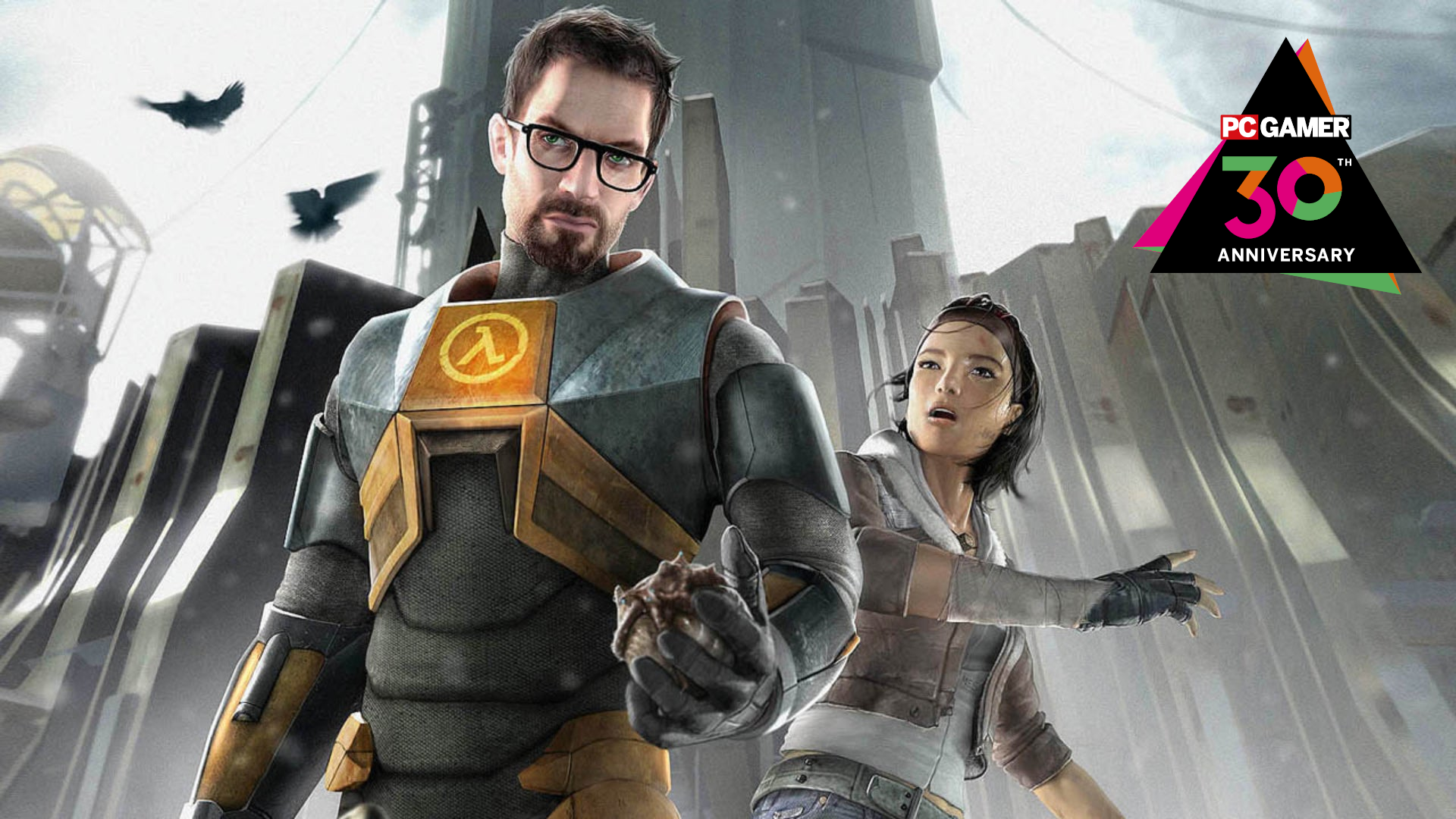
- Half-Life 2 (Nov 2004)
- World of Warcraft (Nov 2004)
- Oblivion's horse armour (Apr 2006)
- Dwarf Fortress (Aug 2006)
- The Orange Box (Oct 2007)
- Plants vs Zombies (May 2009)
- Recettear: An Item Shop's Tale (Sep 2010)
- Minecraft (November 2011)
- The Elder Scrolls V: Skyrim (Nov 2011)
- XCOM: Enemy Unknown (Oct 2012)
- Steam Early Access starts (Mar 2013)
- Oculus Rift DK1 (Mar 2013)

This article first appeared as part of a supplement included with our blowout 30th anniversary issue of PC Gamer magazine, issue 390, in November 2023. Pick it up for a look back at the magazine's own storied history.
As PC Gamer's 30th anniversary celebrations continue, we're taking a trip back through three decades of PC gaming. In part 1, we looked at the early days of 1993-2003; now, we step firmly into the mid-2000s, and discover a game that changed everything and launched the defining PC gaming platform...
Half-Life 2 (November 2004)
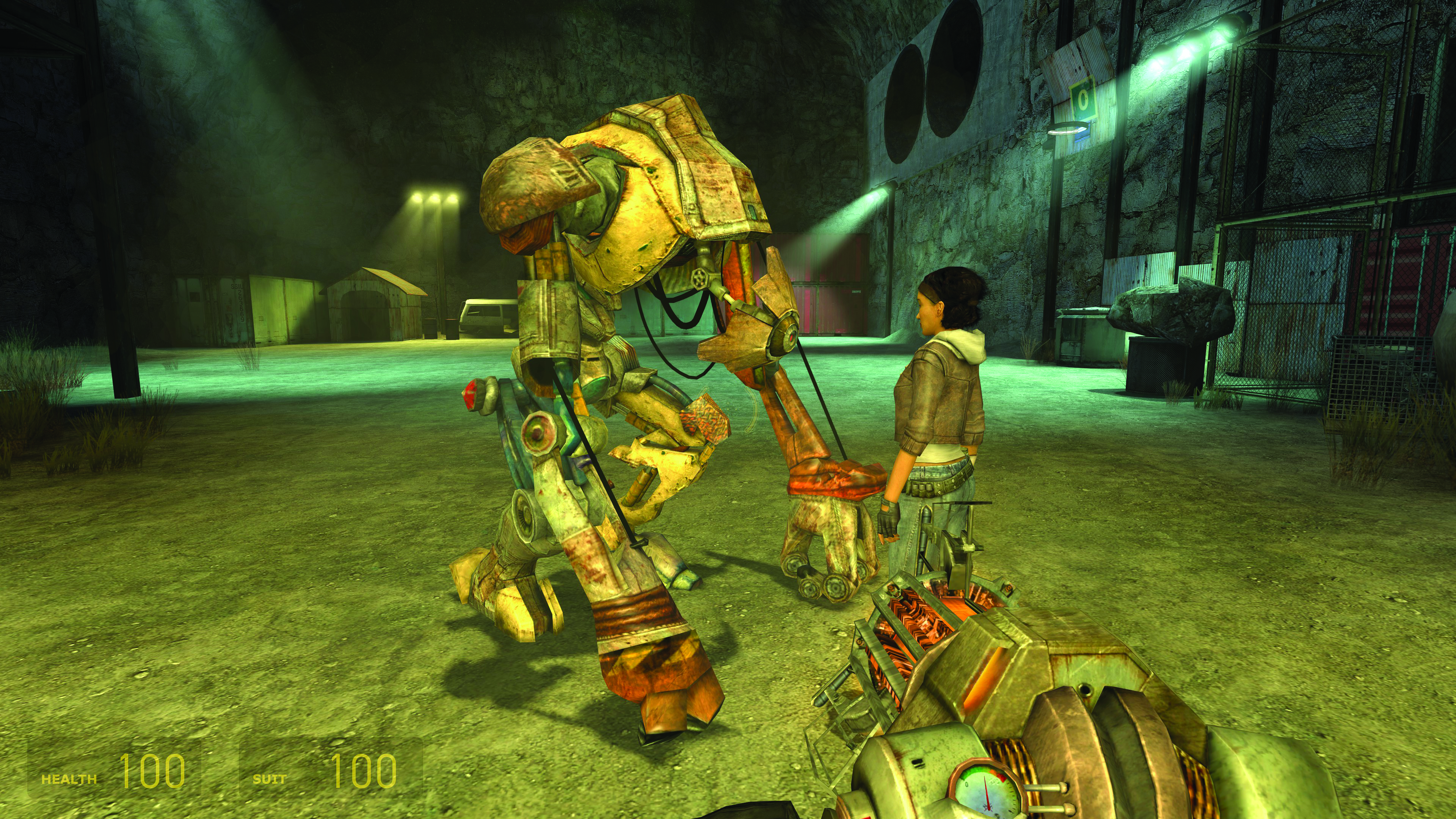
In history there are two games industries: the one that lived before Half-Life 2, and the one that woke up after it. Half-Life 2 was the sum of all the FPS' aspirations. A realistic, contiguous 3D environment that saw players travelling through a vast and elaborate cityscape. A revolutionary physics engine that turned every object in the game world into a potential weapon. An endlessly inventive adventure in which every chapter brought new twists. A story told by characters who moved, talked, and acted like real people.
Even at a time when shooters and first-person games were constantly breaking new ground, nobody had seen anything like Half-Life 2. It was so good that Valve, with all its collective brainpower, still hasn't figured out how to make a sequel to it.
The influence of Half-Life 2 stretches as wide as it does deep. Without Half-Life 2 there'd be no Garry's Mod, no Dear Esther, no Portal, and all the games those titles inspired. But by far Half-Life 2's most significant impact was to make Steam a going concern. PC gamers may have hated taking their medicine before they could play the best game on the planet, but the additional install base Half-Life 2 provided was the first major step in transforming Steam into the behemoth it is today, and by proxy, shunting the entire medium into a digital future. Not since Doom had there been a PC game that so fundamentally changed everything, and another wouldn't come along until Minecraft.
World of Warcraft (November 2004)
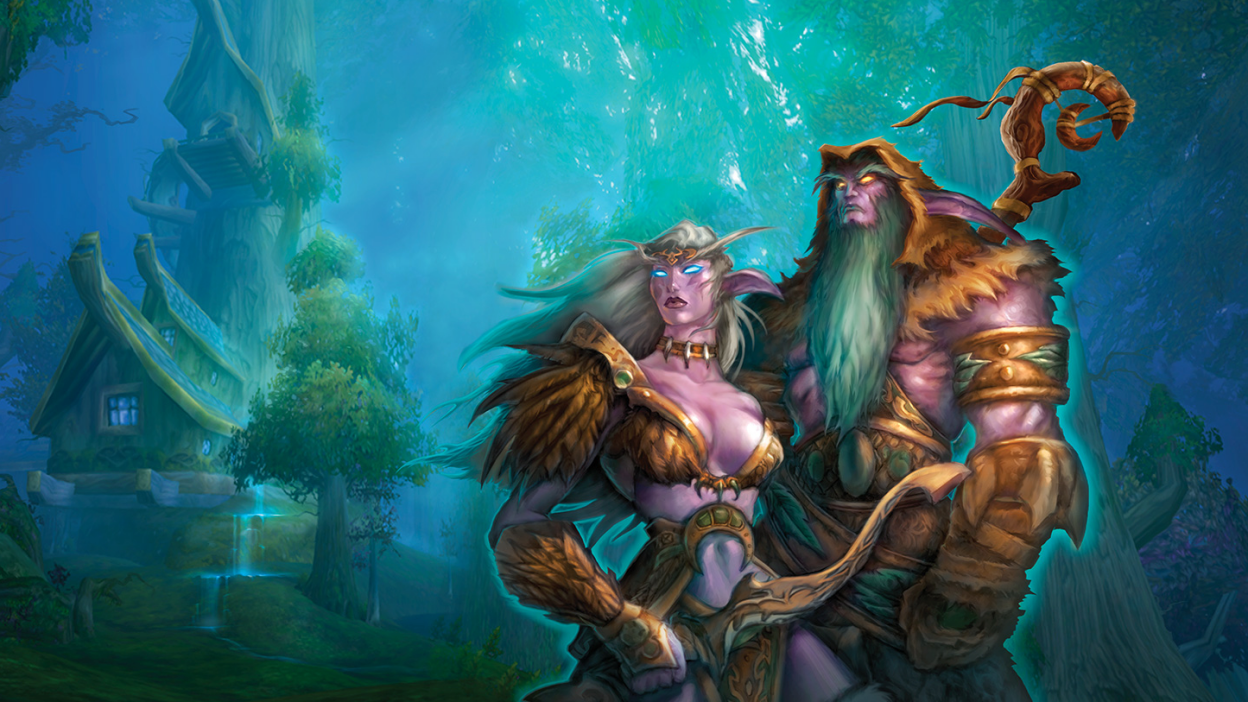
World of Warcraft is a bizarre videogame phenomenon, in that it both started and ended the MMO craze of the noughties. Every publisher wanted a piece of World of Warcraft's action, but hardly any would come close to Blizzard's success. World of Warcraft opened the gates to the MMO party, then kicked the arse of anyone who tried to touch the cake.
The biggest gaming news, reviews and hardware deals
Keep up to date with the most important stories and the best deals, as picked by the PC Gamer team.
What's especially remarkable about this is, before World of Warcraft launched, all eyes were on Everquest 2. At that time, SOE's Everquest was the best MMO going, and the sequel looked set to provide a substantial upgrade, with improved visuals and less punishing progression.
Admittedly, Everquest 2 did all those things. World of Warcraft merely did them better. Blizzard took the lessons it learned from games like Diablo and StarCraft and used them to refine everything that made MMOs fussy and obscure. Its death penalty system was both lenient and imaginative, while its auction houses made trading items with other players a breeze. Alongside this was slicker storytelling and quest design, and state-of-the art PvP that divided players into two warring factions. You could even fly across the map on mounts like gryphons.
In the end, World of Warcraft just buried Everquest 2. And it would do the same for virtually every MMO that followed in its wake. While a few titles like Guild Wars and Lord of the Rings Online were innovative or illustrious enough to cobble together a reasonable following, so many more died quietly within a few years of launch. Only Final Fantasy 14 has proved anything like competitive, and that's after the game was competely redesigned.
All the while, World of Warcraft kept on succeeding, with each expansion building upon the game's foundation, or in the case of addons like Cataclysm or Shadowlands, overhauling it entirely. Indeed, the game has changed so much that Blizzard released the original version again as WoW Classic, for players who wanted to go back to its first iteration. World of Warcraft: so good they launched it twice.
Oblivion's horse armour (April 2006)
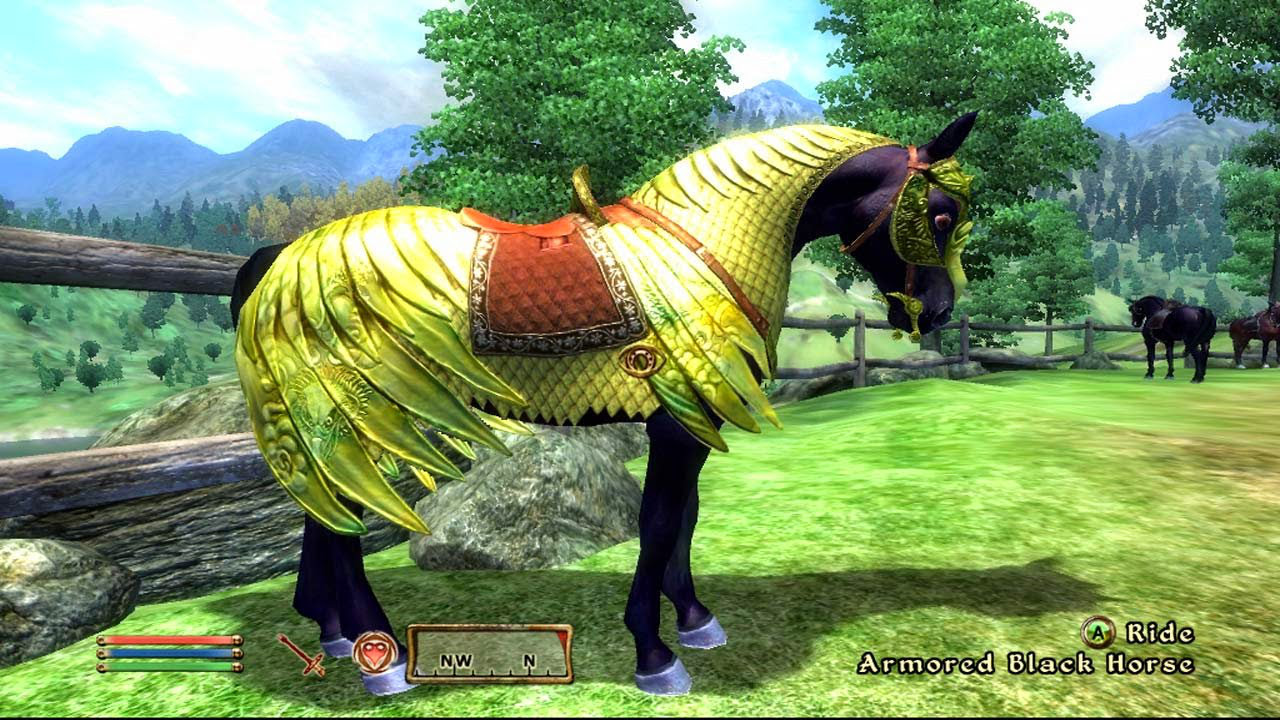
In 2006 Bethesda was the most exciting game studio around. Its new RPG Oblivion had blown players away with its vast, beautiful, and endlessly surprising fantasy world. But Bethesda's popularity soon took a dent when it launched Oblivion's first slice of additional content. This differed in two ways from previous expansions Bethesda had made, like Tribunal and Bloodmoon for its earlier title Morrowind. First, it was delivered entirely digitally. Second, it wasn't a new island to explore or adventure to tackle. No, it was a bit of armour for your horse.
The stink this caused was unbelievable. While players weren't against paying for additional game content, the idea of shelling out money specifically for one in-game item was ludicrous. One commenter on the website 1UP around the time of release wrote, "I am going to pay a 'premium' for a nifty hat?" unwittingly predicting Valve's entire business plan for the 2010s.
Looking back now, what's most remarkable is how mundane this all seems. Today, virtually every game has optional payable content, whether it's in the form of expansions, DLC, microtransactions, battle passes, season passes, or loot boxes. It's taken as read that most games, especially bigger titles, will be orbited by a ring of fragmentary extras. A paid item being entirely cosmetic is considered a good thing, as it means players aren't missing out on a potentially meaningful feature.
What changed? Well, partly this was normalised through sheer inundation, not just of payable DLC, but of games in general. As the volume and size of available games increased, the debate over smaller pieces of payable content seemed to matter less. When you've got three 80-hour open-world games on the go, plus 100 hours in a free-to-play shooter, the option to buy an extra suit in one of those games doesn't seem so offensive.
That said, paid extras can still be contentious. Loot boxes remain controversial due to the gambling element that plays into them. Star Wars: Battlefront (2017) was savaged for its cynical loot box implementation, a criticism that stained the game's reputation long after it was resolved. Which goes to show, you're only one shortsighted business decision away from becoming the next bit of horse armour.
Dwarf Fortress (August 2006)
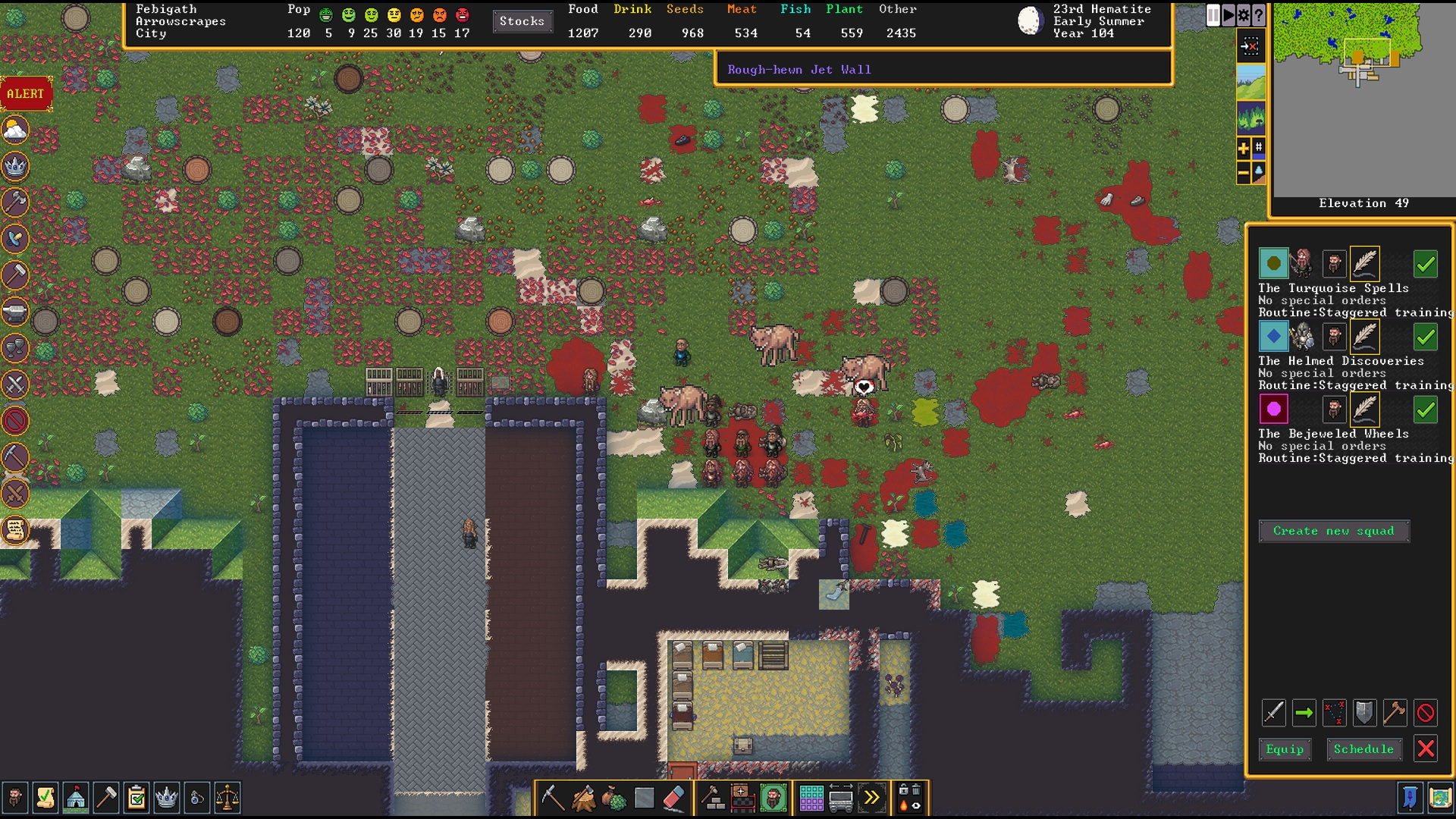
Never has a game been so simultaneously behind and ahead of the times as Dwarf Fortress. Released in 2006, Dwarf Fortress was a preposterously complex management sim at a time when management sims were out of vogue. It was a game fronted by impenetrable ASCII graphics, at a time when the industry was moving toward increased visual fidelity and streamlined interfaces.
By all rights, Dwarf Fortress should had vanished into internet obscurity. At the same time, it's quite hard to ignore a game that generates an entire history of civilisation before you start to play. Notionally about building and managing a home for a colony of dwarves, Dwarf Fortress is really an impossibly complex story engine designed to factor in every possible eventuality. It's not just a game where your dwarves fight procedurally generated monsters in a procedurally generated land, but one where they have procedurally generated personalities and can write procedurally generated poetry.
Dwarf Fortress would go on to inspire other colony sims like Prison Architect and RimWorld. These games didn't have quite the same depth as DF, but were significantly easier to grapple with. All that changed late last year, however, when Bay12 released a new version of Dwarf Fortress sporting *gasp* hand-drawn graphics and *swoon* a user interface that supported a mouse. This made Dwarf Fortress significantly more accessible, and made Bay12's designers millionaires. All it took was 20 years building the most complex game ever made.
The Orange Box (October 2007)

Valve is a company that likes to solve problems, and in 2007 the problem was that none of its current projects—Team Fortress 2, Half-Life 2: Episode Two, and a weird experiment called Portal—really felt like a full game. But Valve realised each project filled in the gaps where the others fell short. So was born the greatest videogame anthology in history.
Before launch, the headline act was Episode Two. Although Episode One hadn't been quite up to the same standard as Half-Life 2, Episode Two promised terrifying new enemies, advanced vehicular mechanics, and some big story twists.
Ultimately though, Episode Two proved the least exciting part of the box. Team Fortress 2 brought a radical new aesthetic to Valve's Quake-mod-inspired shooter, one perfectly suited for the cartoonish chaos of a multiplayer FPS. But the most astonishing of the trio was Portal, which brought a genuinely revolutionary game mechanic to the table, packaged in a brilliantly brain-teasing puzzler overseen by one of gaming's greatest comic creations.
The legacy of The Orange Box isn't entirely without blemishes. Valve's handling of Team Fortress 2 has been questionable, and Half-Life 2 never did get a proper ending. Nonetheless, The Orange Box represents Valve at the height of its creative powers, and I'd give my little finger to see the company do something this bold again.
Plants vs Zombies (May 2009)
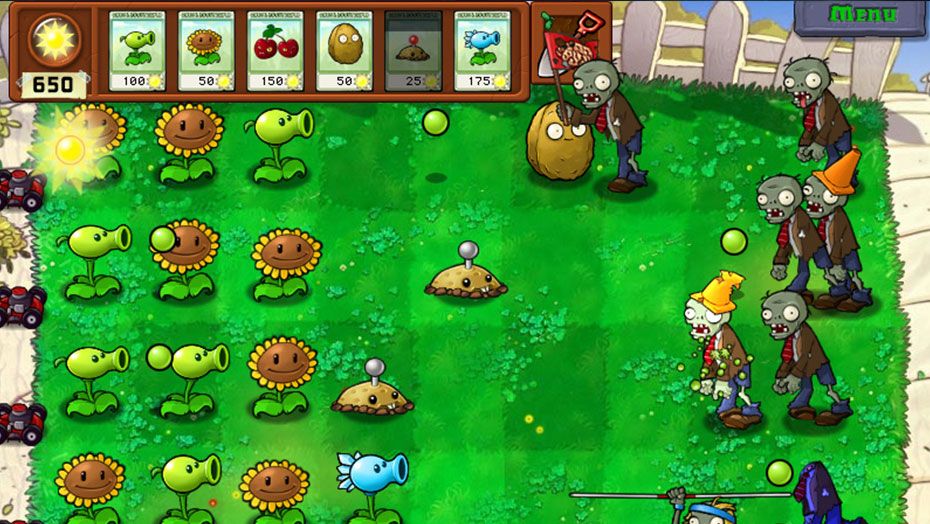
Like Peggle before it, Plants vs Zombies was instrumental in the normalising of 'casual' games on PC. Valve's inclusion of a demo version of Peggle in The Orange Box had countless PC gamers paying attention to what PopCap would do next.
Plants vs Zombies showed that games you'd normally find free on Newgrounds.com could compete with shooters and RPGs as premium mainstream titles. Then PopCap was acquired by EA, and Plants vs Zombies disappeared into mobile-land. But the original's significance as a PC landmark remains. It's also the second best game after Portal to finish on a song.
Recettear: An Item Shop's Tale (September 2010)
You might not be familiar with Recettear, in which you play a young girl in a magical shop who explores randomised dungeons. But it's notable for being the first Japanese game to release on Steam.
Prior to this, the PC was rarely a focus for Japanese publishers. You'd occasionally see a port of a Capcom or Sega game, but that was it. Yet Steam revealed the PC market was too big to ignore. Recettear was the first crack in the dam, leading to everything from Dark Souls to Yakuza, Persona to Nier Automata arriving on the platform. You can even play Shenmue on PC now. What an age we live in.
Minecraft (November 2011)
While Minecraft officially released in late 2011, it had already been a sensation for over a year. Its highly public alpha development is one of many reasons why Mojang's cubic omni-game was revolutionary, and there's a direct line from it to today's Early Access.
It also changed the types of games being made. Minecraft's groundbreaking survival mechanics paved the way for titles like DayZ, Subnautica, and Fortnite, while its block-based building system directly influenced the likes of Factorio and Satisfactory. It's wild just how much of today's gaming landscape was shaped by Minecraft.
The Elder Scrolls V: Skyrim (November 2011)
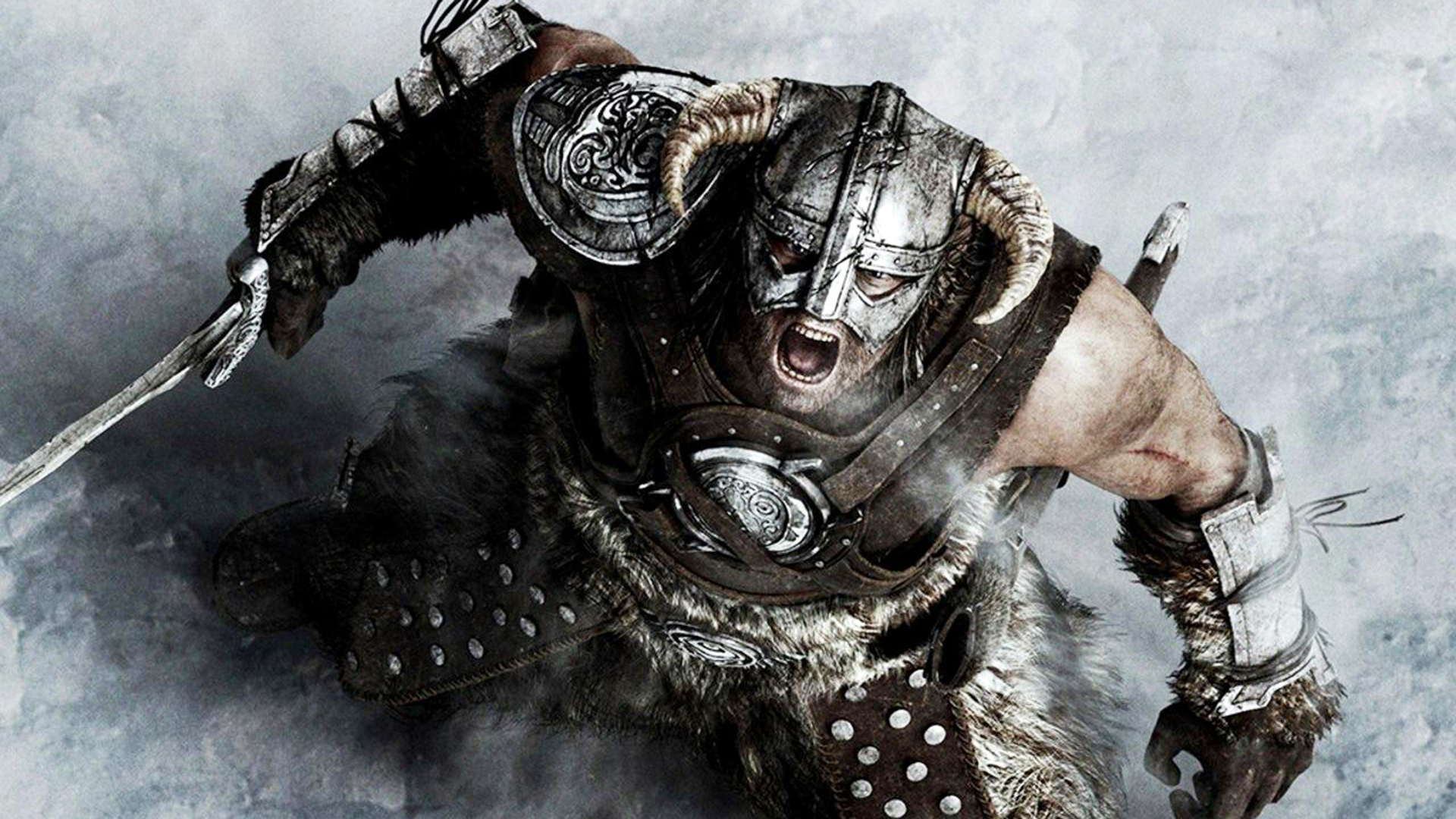
Bethesda's finest hour. Skyrim combined the refinements of Oblivion with a less cod fantasy landscape inspired by Norse myth. The rugged mountains and misty valleys brought back some of the weirdness Bethesda had left behind in Morrowind. Also, it had dragons.
The result was a perfectly balanced RPG brew. Skyrim had just enough sharpness in its combat and intuitiveness in its systems to give it mass-market appeal, but it also had sufficient flexibility and, let's face it, inherent wonkiness to make it an internet sensation in the golden age of social media. Buckets on heads! Oaths to carry burdens! A certain projectile in a leg joint! It was the same weirdness that had been in Oblivion, but unlike in 2006, it was a lot easier to share.
Which is not to say everyone loves Skyrim purely because of the memes. So much of Skyrim's memetic potential derives from its openness, its willingness to let you bend and even break it. Nowhere is this more apparent than in Skyrim's unrivalled mod scene. From new inventories to enhanced survival systems, novel quests to entire unexplored areas. Forget waiting for The Elder Scrolls VI, you could probably assemble a sequel yourself just out of Skyrim mods.
Since Skyrim, Bethesda's games have lost some of that openness. Fallout 4 leaned far more heavily on its shooter credentials, while Starfield lacks a contiguous play-space capable of generating oddball moments. They're still decent adventures, but the sooner Bethesda gets back to The Elder Scrolls, the better.
XCOM: Enemy Unknown (October 2012)
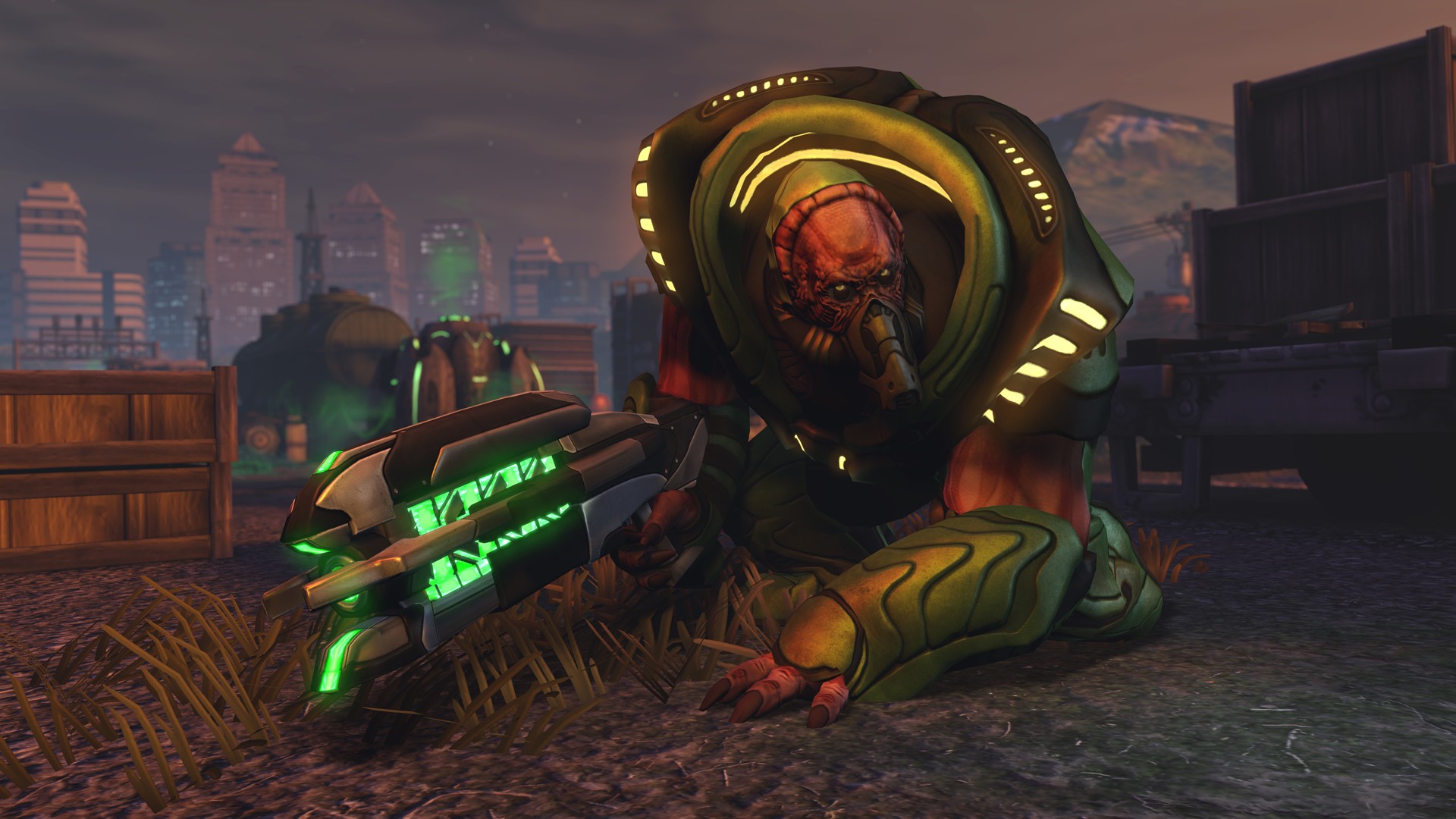
Firaxis' reboot of Julian Gollop's 1994 game (known variously as X-COM: UFO Defense and UFO: Enemy Unknown) is another one of those great pivot moments of PC Gaming. Before XCOM, turn-based tactics was practically a forgotten genre. But Firaxis brought it screaming back, blending cinematic flair with ruthless tactical challenge to create a gripping, dynamic sci-fi drama. XCOM's tactical scenarios could deliver the kinds of shocking twists you'd normally experience in a TV show like Game of Thrones, only the characters being mercilessly slaughtered were ones you'd created, in situations you'd got them into.
XCOM also fit right into the 2010s' renewed appetite for uncompromising experiences, a more cerebral companion to the high-wire athleticism of Dark Souls. Its alien menace wasn't afraid to just beat you, but to humiliate you too, and even the best outcomes came with losses. As such, completing a mission in XCOM always felt like a huge achievement. And winning a campaign? Well, pat yourself right on the back.
In the wake of XCOM, turn-based tactics went from forgotten genre to arguably the dominant strategy mode for the next decade, inspiring everything from Gears Tactics to Invisible, Inc. Turn-based tactics even began infiltrating other genres. Role-playing games like Wasteland 2 and Baldur's Gate 3 owe as much to XCOM as they do the CRPGs of the '90s. Going forward, the 2010s would see a string of highly successful reboots, including Tomb Raider, Wolfenstein: The New Order and Doom, but none of them were as transformative as Firaxis' tactical masterpiece. Hurry up Commander, we need you back.
Steam Early Access starts (March 2013)

Although Minecraft first seeded the idea of paying for an incomplete game, it was Valve that formalised the concept. In March 2013, 12 games launched as part of Steam's Early Access programme, letting developers sell unfinished titles, using player funds and feedback to complete the project. The list included ArmA 3, Kerbal Space Program, and Prison Architect.
The idea of paying for unfinished games risked further fragmentation of games as a product, a process that had already begun with DLC and microtransactions. There was a fear developers might abuse the system to escape scrutiny, responding to criticism of flawed or poor design with "it's not finished", or simply taking the money and running.
And Steam Early Access has been misused on occasion. But, on the whole, has been a huge net positive for PC gaming. Of the 13 games that originally launched in Steam Early Access, three eventually ceased development, but ten saw full launches, and at least one, Kerbal Space Program, is among the greatest PC games ever made. That's not to mention all the brilliant games to emerge from Early Access since, like Slay the Spire, Vampire Survivors, and of course Baldur's Gate 3.
Rather than representing a threat to how games are made, Early Access acknowledges the highly iterative and collective nature of game development. Whether a game is finished or not comes down to one thing, the developer's choice, and Steam Early Access simply helped expand their options.
Oculus Rift DK1 (March 2013)
You could play a crude VR version of Half-Life 2 on the Oculus Developer's Kit 1. It was grainy, it was disorienting, and it made some feel sick. But the Combine soldiers were actually human-sized, the vertical drops made stomachs lurch, and the headcrabs leaping at your face were terrifying.
In 2013, it felt like virtual reality would take over the world. Physical and economic limitations have prevented a VR revolution, but the tech is nonetheless a well-established part of PC gaming today. If nothing else, VR brought us a whole new Half-Life game, Half-Life: Alyx, every bit as brilliant as the first two.
Rick has been fascinated by PC gaming since he was seven years old, when he used to sneak into his dad's home office for covert sessions of Doom. He grew up on a diet of similarly unsuitable games, with favourites including Quake, Thief, Half-Life and Deus Ex. Between 2013 and 2022, Rick was games editor of Custom PC magazine and associated website bit-tech.net. But he's always kept one foot in freelance games journalism, writing for publications like Edge, Eurogamer, the Guardian and, naturally, PC Gamer. While he'll play anything that can be controlled with a keyboard and mouse, he has a particular passion for first-person shooters and immersive sims.

